
Lawn Maintenance
Lawn Maintenance
As homeowners increasingly seek to enhance the aesthetic appeal of their properties, understanding the Lawn care industry trends becomes essential for successful yard upkeep. The demand for beautifully maintained lawns and gardens has surged, leading to innovative practices and products that promote healthy grass and sustainable landscaping. By staying informed about these trends, homeowners can make educated decisions regarding their turf management, ensuring that their outdoor spaces remain both attractive and environmentally friendly.
Similarly, the evolving landscape of the lawn care industry trends emphasizes the integration of technology and eco-friendly solutions. From smart irrigation systems to organic fertilizers, modern advancements are revolutionizing grass maintenance techniques, enabling efficient and sustainable yard upkeep. As consumers become more environmentally conscious, businesses in the lawn care sector are adapting their services and products to meet these new expectations, highlighting the importance of staying current with these trends for maintaining lush and healthy lawns.
Hydration Techniques to Lush Lawn
Establishing effective hydration methods is essential to promoting the vibrant grass. It includes knowing the requirements of the grass considering aspects including climate, type of soil, and grass variety. Thorough hydration once a week is generally advised as it supports more profound root systems.
Moreover, the timing of watering is an important factor for effective lawn care. Watering in the early morning is the best option to minimize water loss and enable the lawn to utilize water effectively. Utilizing irrigation systems that offer a gradual distribution of water may aid keep moisture levels in the soil while stopping excess runoff. Keeping an eye on local weather patterns also guarantees that you hydrate the grass correctly.
Tips for Proper Watering Methods
Effective irrigation can be a key aspect in lawn care. Grasping appropriate volume of moisture your lawn needs turns out to be vital. This can be recommended to water early in the morning when temperatures are cooler. Doing so ensures the water to soak deeply into the soil prior to disappearing in the heat of the day.
Moreover, adopting efficient irrigation techniques can help reduce water while fostering a lush lawn. Evaluate using a soaker hose or drip irrigation system as a way to deliver water directly to the roots without waste. Keeping track of soil moisture can also aid decide when it is time to water again. By applying these strategies, you can guarantee a healthy and thriving lawn.
Finding the Best Grass Variety for The Environment
Selecting the appropriate lawn variety is essential for a lush garden. Several lawn breeds thrive under specific climatic conditions. To illustrate, cold-season grasses like perennial ryegrass perform well in northern regions, while hot-season grasses like Zoysia are suited to hotter climates. Understanding your climatic environment serves as a key factor when making a choice which lawn variety to select.
When you have a grasp on your climate, the next step is to think about other factors that can influence your lawn choice. Earth type, sun exposure, and irrigation availability all have a role in how well a certain lawn variety will thrive. For example, if you have poor soil, you might want to opt for lawn varieties that are more tolerant to those conditions. Additionally, if your lawn receives full sun, opting for a lawn that prefers sunlight will assist in a more healthy landscape.
Considerations for Choosing the Grass Type
Choosing the suitable lawn variety is often essential for attaining an vibrant yard. Factors include climate elements in your area. Warm season types thrive under hot weather, while cool-season flourishes best during cooler weather patterns.
Another factor is the property's intended use. High-traffic benefit from resilient turf that are able to endure heavy foot traffic. Furthermore, the type of soil along with sunlight need to be considered to ensure the picked grass will thrive in your environment.
Sustainable Yard Practices for Sustainable Property Owners
Maintaining the yard with an sustainable method does not only aid the ecosystem, it also encourages the vitality of your lawn. Employing organic nutrients as well as weeding methods that are safe for your people and animals can be a wise choice for anyone looking to lower their impact on nature.
Implementing sustainable methods such as using compost clippings to act as mulch or putting in local flora can enhance your lawn's appearance while preserving local wildlife. Selecting local lawns that demand less water and which are more tough in response to environmental elements serves as a efficient way to ensure a vibrant yard without unnecessary resource use.
Reasons to Going Sustainable in The Lawn
Opting for organic approaches in your lawn provides countless reasons. One reason is the favorable impact on the surroundings. Organic practices lessens the use of harmful chemicals that can contaminate soil and negatively affect local wildlife. Through embracing these practices, individuals contribute to a healthier planet while enjoying a lush and vibrant lawn.
An additional benefit of choosing organic lawn care is improved soil health. Organic fertilizers promote the growth of beneficial microorganisms in the earth, leading to enhanced nutrient availability for your lawn. Robust soil results in more drought resistance and reduced susceptibility to pests and diseases. Ultimately, choosing organic is not only helpful for the environment but also creates a thriving and resilient lawn.